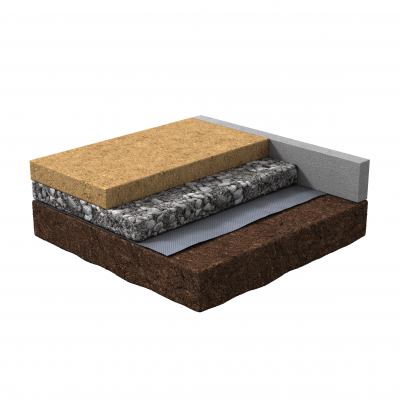Q: Is self-binding gravel porous?
A: Self-binding gravel is not porous and therefore requires a cross fall or camber to channel water from the surface into adequate drainage. Q: What depth is self-binding gravel laid to?
A: Self-binding gravel is laid to a finished compacted thickness of 50mm, ensuring that fines do not float to the surface when water rolled. Q: What edges are required when installing self-binding gravel?
A: Edges are optional; concrete, timber, metal or stone edges can be used and will help achieve the fullest compaction; however, edges should not stand proud of the self-binding gravel. Q: Can self-binding gravel be laid on a slope?
A: It is not recommended to lay self-binding gravel on slopes steeper than a 1-in-5 gradient. This is because the action of storm water flowing across the surface can cause damage to the material, resulting in the occurrence of pot holes and ruts. The installation of steps at irregular intervals will reduce this risk and the overall damage of the surface. Q: What is the minimum/maximum gradient to channel surface water?
A: An adequate gradient for smaller areas, such as footpaths, would be 1-in-50 to allow water to channel from the surface. For large surface areas, such as car parks, a minimum of 1-in40 would be the preferable gradient (25mm drop for every metre of width). Q: How long does self-binding Gravel take to set?
A: The installation of self-binding gravel is very much weather dependant. It can vary between 1-2 weeks or even longer in damp, cold conditions. For the first 3 months, self-binding gravel should be treated with care whilst gaining strength. After this period, the more the area is used, the better is will perform. Q: Will the material pick up on my shoes?
A: Self-binding gravel is a natural material and will pick up on shoes, especially when the material is wet. The dusting effect will lessen with time once the material has been weathered, but a paved area or good door mat is advised before entering buildings. Q: Is self-binding Gravel available in other colours?
A: Self-binding gravel is available in Golden Amber, Red or Silver. All colours lend themselves to natural historical and modern-day surroundings. Q: Is self-binding gravel suitable for bridleways?
A: Yes, however, bridleways are often located in woodlands or fields, meaning the sub-base should be above ground level to allow water to drain off the surface. If the bridleway is lower than the surrounding area, water will flow down onto the bridleway and will pond, causing weakness to the surface and potential potholes. Please note, it is not recommended to lay self-binding gravel on areas where horses may bolt or gallop. Q: Is self-binding gravel suitable for wheelchair use?
A: Yes, self-binding gravel provides a solid bound base which does not separate or segregate with wheelchair use. The surface does lightly scarify with use leaving a dressing of grit/chippings on the surface. Please note, that this may pick up on shoes or wheels, so it would be recommended for a paved area or good door mat is advised before entering buildings. Q: Can self-binding gravel be used in tree pits?
A: Self-binding gravel must be laid onto compacted type 1 sub-base; if it is not possible to roll the material around tree pits, then hand compaction is the other option. There must be watering points for the trees as self-binding gravel is not porous. Please note, that movement of the tree roots in time may cause cracking of the material and after rainfall continual drips from branches may wash away the fines content, leaving coarse chippings on the surface. Q: What is the pH value of self-binding gravel?
A: The pH value of self-binding gravel is 8.3. Q: What if potholes occur?
A: If a pothole occurs it must be repaired as soon as possible. If the pot hole is left, there is a risk of rainwater lying in the hole and ingress into the self-binding gravel, making the pothole larger. Q: What can self-binding gravel be laid on?
A: Self-binding gravel is installed onto MOT Type 1 Stone. The subbase should be dry, level and compact. Any deviations should be such that when a 3m long straight edge is placed in any position on the surface, the gap between the straight edge and the surface should at no point be greater than +/-6mm. Q: How long will self-binding last for?
A: Self-binding gravel is a 100% natural product, so it depends on how the material is treated as to how long it lasts for. Q: Can self-binding gravel be laid in the rain?
A: Laying self-binding gravel in the rain can prove beneficial as it helps the water rolling process; provided the rain is not so intense that it washes away the fines content. | 